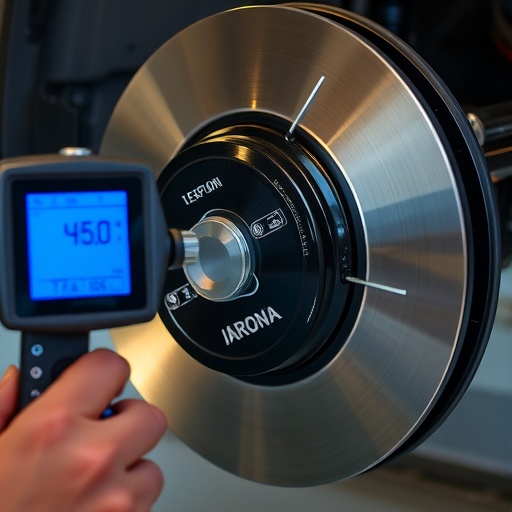In an era characterized by growing concerns over environmental sustainability and air quality, the focus on vehicular emissions and associated pollutants has never been more pronounced. Recent research conducted by a team of experts, led by Al Wasif-Ruiz, Suárez-Bertoa, and Sánchez-Martín, has unveiled critical insights into a largely overlooked aspect of vehicular pollution: brake wear particles. In their landmark study, the authors present a direct measurement of these particles emitted from light-duty vehicles under real-world driving conditions, setting the stage for both public awareness and future regulatory actions.
The significance of this study cannot be overstated. Brake wear particles are a form of particulate matter, which are minute solid or liquid particles suspended in the air. While conventional wisdom tends to prioritize exhaust emissions in discussions of vehicular pollution, the reality is that brake systems also contribute to the accumulation of harmful pollutants. These particles can range from metal fragments to organic compounds and have been identified as a contributor to air quality degradation, potentially affecting human health and the environment.
In the intricate testing involved in their research, the team utilized cutting-edge technologies to capture and analyze the emissions produced from standard braking activities. This involved deploying sophisticated equipment designed to measure not only the mass of the brake wear particles but also their chemical composition. By employing a mix of on-road testing and lab analysis, the researchers were able to develop a comprehensive profile of the pollutants emitted during real-world driving.
One of the most intriguing findings detailed in the study is the variability in brake wear particle emissions based on various driving conditions. Drivers often encounter diverse environments—such as stop-and-go traffic, highway driving, and even inclement weather. Each of these conditions influences the frequency and intensity of braking events, thereby affecting the quantity and type of wear particles generated. Understanding these dynamics is crucial not only for vehicle manufacturers but also for public health officials tasked with developing air quality standards.
As cities around the world grapple with the implications of increased vehicular traffic, this research underscores the importance of considering all sources of pollution in comprehensive urban planning. While initiatives such as low-emission zones and electric vehicle incentives focus primarily on decreasing exhaust emissions, the findings from Al Wasif-Ruiz and his colleagues reveal that a more holistic approach is required. City planners and policymakers must integrate strategies that also address brake wear as a source of particulate pollution.
Moreover, the study sheds light on the potential health implications associated with exposure to brake wear particles. When inhaled, these particles can penetrate deep into the lungs, leading to respiratory problems, cardiovascular issues, and other health complications. Populations living in urban environments, particularly those close to busy roadways, may be at greater risk. As awareness of the health impacts related to air quality increases, it is imperative that research like this informs public health campaigns and regulatory frameworks aimed at protecting vulnerable communities.
Additionally, the findings open up discussions around the materials used in brake manufacturing. Many brake systems incorporate various metals and compounds that, when worn down, contribute to the particulate matter released into the atmosphere. The move towards greener alternatives in manufacturing could play a pivotal role in mitigating the effects of brake wear on air quality. Researchers and industry leaders alike are called upon to explore innovative materials that result in less harmful emissions without compromising vehicle safety.
The impact of this study extends into the automotive industry, prompting manufacturers to re-evaluate existing technologies and materials used in brake systems. The revelation that brake emissions can rival those of exhaust presents both a challenge and an opportunity for innovation. Automotive engineers will need to develop solutions that not only enhance vehicle performance but also minimize harmful byproducts. This could involve advancements in brake design, the adoption of more durable materials, and improvements in braking technology that reduce wear.
Public response to such findings is equally critical. The awareness generated by the research is likely to stimulate consumer demand for cleaner vehicle technologies. Informed consumers may push for transparency from automakers about the emissions produced by their vehicles, including those related to brake wear. This shift in market dynamics could accelerate the transition towards environmentally conscious practices in the automotive sector.
Furthermore, these findings underline the need for more extensive research into the effects of brake wear particles on ecosystems. As these pollutants settle on roadways and nearby environments, they can impact soil and water quality. Investigating the long-term effects of brake wear particles in natural habitats could provide vital information necessary for environmental conservation strategies.
This study is a timely reminder of the complexities surrounding motor vehicle emissions and the importance of continuous research. As the global community shifts its focus towards sustainability and environmental health, studies like this one can illuminate the pathways towards effective interventions. Whether through regulatory changes, technological advancements, or public awareness campaigns, it is evident that addressing the implications of brake wear particles is integral to fostering a healthier planet.
In conclusion, the pioneering research by Al Wasif-Ruiz and colleagues opens a new chapter in our understanding of vehicular emissions. By directly measuring brake wear particles and their real-world impacts, they have highlighted an often-overlooked source of pollution that warrants attention. As we strive for cleaner air and healthier communities, integrating findings from such research into broader discussions about transportation policies and environmental regulations will be crucial.
Subject of Research: Brake wear particles from light-duty vehicles under real-world driving conditions.
Article Title: Correction to: Direct measurement of brake wear particles from a light-duty vehicle under real-world driving conditions.
Article References:
Al Wasif‑Ruiz, T., Suárez‑Bertoa, R., Sánchez‑Martín, J.A. et al. Correction to: Direct measurement of brake wear particles from a light‑duty vehicle under real‑world driving conditions. Environ Sci Pollut Res (2025). https://doi.org/10.1007/s11356-025-37053-4
Image Credits: AI Generated
DOI:
Keywords: Brake wear particles, vehicular emissions, air quality, public health, environmental sustainability.




